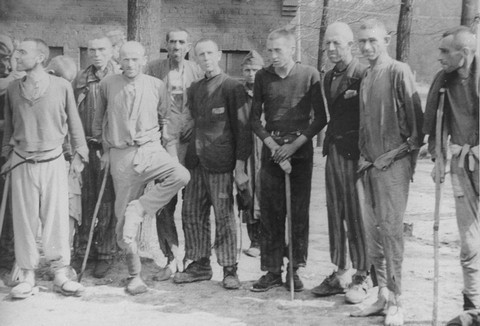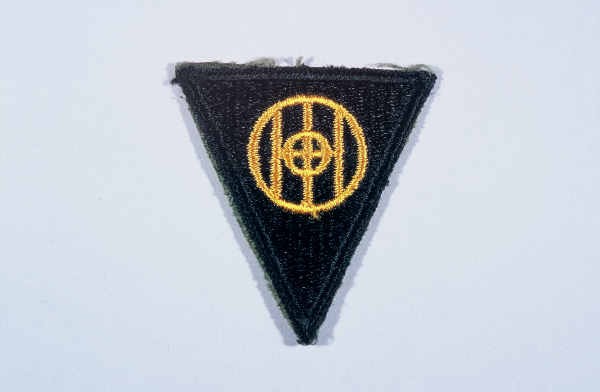The 83rd Infantry Division during World War II
In 1985, the United States Holocaust Memorial Museum and the US Army Center of Military History began a program to honor US Army divisions that took part in the Allied liberation of Nazi camps. The US Army Center of Military History defines a liberating division as one whose official records show its presence at a camp within 48 hours of the first soldier’s arrival. The 83rd Infantry Division is among the 36 US divisions that have been recognized to date.
Key Facts
-
1
US, British, Soviet, and Canadian troops encountered concentration camps and other sites of Nazi crimes as they advanced across Europe in 1944 and 1945.
-
2
The Allied soldiers liberated sick and starving camp prisoners from Nazi tyranny. They also provided them with food, clothing, and medical aid.
-
3
The United States Holocaust Memorial Museum and the US Army Center of Military History have recognized 36 US divisions for their role in the liberation of Nazi camps.
83rd Infantry Division Campaigns during World War II
The 83rd Infantry Division was first activated in the fall of 1917, several months after the United States entered World War I. It was deployed to France in 1918.
On June 18, 1944, less than two weeks after the Allied D-Day invasion of western Europe, the "Thunderbolt" division landed on Omaha Beach and began advancing into France. By the end of September, the division had moved into Luxembourg. In late December 1944, the 83rd took part in the Allied effort to stop the German offensive in the Battle of the Bulge. Several months later, it crossed the Rhine and subsequently captured the German city of Halle on April 6, 1945. At war's end, the "Thunderbolt" division had established a bridgehead on the Elbe River.
The 83rd Infantry Division and the Liberation of Langenstein
On April 11, 1945, the 83rd encountered Langenstein, a subcamp of the Buchenwald concentration camp. The camp was created in April 1944 to provide concentration camp labor for the German war effort. In its one year of existence, the camp's population greatly expanded from 214 prisoners in April 1944 to about 5,400 in March 1945. The prisoners were detailed to build underground factory installations and to carry out forced labor for Organization Todt.
When the 83rd Infantry arrived in Langenstein, its troops found some 1,100 inmates in very poor physical condition. The unit reported that the prisoners had been forced to work 16 hours a day in nearby mines and that the SS had murdered those prisoners who became too weak to work. Deaths, the division's report continued, reached 500 per month. Upon overrunning the camp, US troops estimated that the newly liberated inmates weighed only 80 pounds each as the result of malnutrition at SS hands. They also estimated that, due to severe physical debilitation, prisoners continued to die at a rate of 25 to 30 persons per day.

To halt the spread of sickness and death, the 83rd ordered the local German mayor to supply the camp with food and water. The unit also requisitioned medical supplies from the US Army's 20th Field Hospital. In addition, the "Thunderbolt" division recovered the camp's documents for use by war crimes investigators.
Recognition as a Liberating Division
The 83rd Infantry Division was recognized as a liberating unit by the US Army's Center of Military History and the United States Holocaust Memorial Museum in 1993.
83rd Infantry Division Battle Casualty Figures
Hundreds of thousands of US servicemen and women died or were wounded in the fight against Nazi tyranny.
The total number of battle casualties for the 83rd Infantry Division in the European Theater of Operations during World War II was 15,910. In this case, “battle casualties” includes all personnel who were unable to fight in battle because they were wounded, missing, captured, or killed.
Among the battle casualties suffered by the 83rd Infantry Division, there were 3,637 deaths.
83rd Infantry Division Nickname and Insignia
Originally, the 83rd Infantry Division’s nickname was "Ohio." This nickname referred to the state where the division was raised during World War I. During World War II, the Division brought in soldiers from all over the United States. In early 1945, the 83rd held a contest and adopted a new nickname: “the Thunderbolt Division.” The contest was held while the 83rd was at the Rhine River across from the German city of Düsseldorf. Despite the change in the 83rd’s nickname, the divisional patch or insignia goes back to its Ohio roots. The insignia is a black triangle that points downward. “Ohio” is spelled out by interlocked letters, one over the other, stitched in gold thread.

Footnotes
-
Footnote reference1.
In the aftermath of World War II, the US Department of the Army compiled casualty figures for US Army personnel. The US government published these figures in 1953. The report listed casualty numbers for the US Army for the period from December 7, 1941 (Pearl Harbor) through December 31, 1946, when US President Harry S. Truman officially declared the end of war hostilities. Army Battle Casualties and Nonbattle Deaths: Final Report, 7 December 1941-31 December 1946, Prepared by the Statistical and Accounting Branch, Office of the Adjutant General, Under the Direction of the Program Review and Analysis, Division of the Comptroller of the Army, O.C.S., (Washington: Department of the Army, 1953), p. 3-4, 84-89.
Critical Thinking Questions
What challenges did Allied forces face when they encountered the camps and sites of other atrocities?
What challenges faced survivors of the Holocaust upon liberation?

